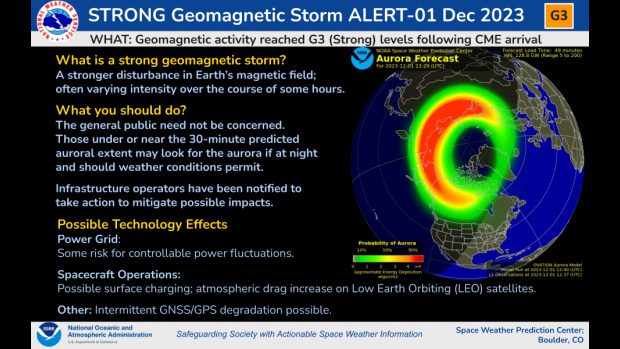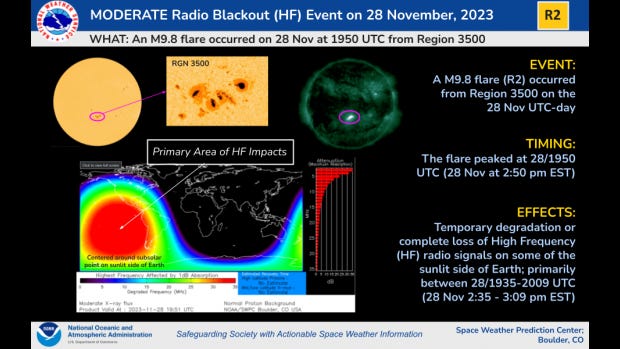Strong Geomagnetic Storm To Hit Earth Saturday
The Space Weather Prediction Center reported a Moderate Radio Blackout Event on November 28th, 2023 when an M9.8 (very powerful) solar flare occurred.
NORTHERN HEMISPHERE - The U.S. Space Weather Prediction Center issued an alert that it expects a strong geomagnetic storm to hit the Earth on Saturday after the sun released a powerful coronal mass ejection (CME), adding that it could disrupt communication systems.
The Space Weather Prediction Center reported a Moderate Radio Blackout Event on November 28th, 2023 when an M9.8 solar flare occurred. An M9.8 is only a few percentage points away from an X-class, which is the most powerful type of solar flare that is known to cause radio blackouts.
At that time it was reported that the effects might be "temporary degradation or complete loss of High Frequency (HF) radio signals on some of the sunlight side of the Earth" at the time.
Coronal Mass Ejections are "large expulsions of plasma and magnetic field from the Sun’s corona," according to the U.S. Space Weather Prediction Center. Such expulsions can inject "billions of tons of coronal material and carry an embedded magnetic field (frozen in flux) that is stronger than the background solar wind interplanetary magnetic field (IMF) strength," the agency states.
It adds, "CMEs travel outward from the Sun at speeds ranging from slower than 250 kilometers per second (km/s) to as fast as near 3000 km/s".
The fastest CMEs directed at our planet can reach the Earth in a matter of 15 to 18 hours after being initially released from the Sun, according to the agency.
On December 1st, the agency reported a G3 (strong) Geomagnetic storm was observed, adding that a geomagnetic storm is a "stronger disturbance in the Earth's magnetic field; often varying intensity over the course of some hours".
It also added that the general public "need not be concerned" and that people who are under or near the 30-minute predicted "auroral extent" may look for the aurora if it happens at night, and if weather permissions allow it.
The agency added that it could have some effects on the power grid with "controllable power fluctuations," and spacecraft operations: "Possible surface charging, atmospheric drag increase on Low Earth Orbiting (LEO) satellites," and intermittent GNSS/GPS degradation is possible.









